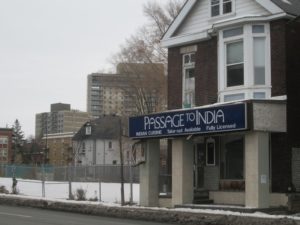Café Le Hibou on Rideau— How café culture arrived in Sandy Hill
Denis Faulkner
An historic site (at least to me) disappeared when the Passage to India restaurant was demolished to make way for the new apartment block, “The Charlotte” now under construction on Rideau Street.

Photo Lena Creedy
Café Le Hibou was started by me and three other University of Ottawa students in November, 1960. The site was 544 Rideau Street on the second floor. The owner at the time, Dr Dupont, resided on the ground floor and had his chiropractic clinic there. (The last occupant of 544 was Passage to India on the ground floor.)
At that time, the legal drinking age was 21 years old, and there was no place for students to “hang out.” We wanted a little café for students, a place to come and chat, or play the guitar, play chess or checkers, have someone read their poetry either in French or in English. As we wanted a Parisian feel to the place, we offered espresso and cappuccinos, thick sandwiches on Kaiser rolls and served as well mocha, chocolate or black forest cherry cakes. The cakes were all made by a student friend of ours, Paul Mostovac with the help of his mother.
It was a meeting place of consequence. My future brother-in-law, Ralph Kretz met my sister there. She was our waitress and she spent more time with him than looking after our customers, it seemed. Ralph still lives in Sandy Hill on Augusta Street. Ironically, I now live on Laurier Avenue East. My former mother-in-law, Ethel Knight, lived on Daly Avenue.
We also had impromptu flamenco guitar sessions with Charles Fischer (Carlos), who spent half a year in Ottawa as a Hansard reporter at the House of Commons, and the other half in Spain. It turned out to be our demise as Mrs Dupont was getting quite annoyed about all the stamping of feet during those sessions. Dr. Dupont “retaliated” by playing awful pop tunes on his electric organ while we were holding our poetry readings every Tuesday night. Every time I paid the rent ($85.00), Dr Dupont hinted that perhaps we should find a larger venue.
As summer arrived, many of our members (we charged $1.00 a year for membership) disappeared. I tried to keep the place going by serving “gourmet meals.” One evening Carlos rushed into the kitchen to tell me that it was the best salmon he had ever had. I had made a salmon teriyaki on rice. Perhaps his beautiful girl friend, his bottle of wine in a paper bag, and sitting at one of the small tables on the veranda made the difference. It was probably the first café terrace in Ottawa at the time, as restaurants were not allowed to have one then.
I realised that I had to find a place where I could engage paid entertainment, and 248 Bank Street was our next home for three years. As it was larger, we had folk, blues singers and chansonniers. We also had English and French theatrical plays and Saturday afternoon children’s theatre with Noreen Young’s puppets.
The last venue was 521 Sussex Drive, an even larger place offered by an acquaintance, John Leaning, then chief architect for the National Capital Commission. Many artists performed in those two venues, both French and English, local, national and international, including Joni Mitchell, Bruce Cockburn, Gordon Lightfoot, the James Cotton Blues Band, as well as French performers such as Pauline Julien, Renée Claude, Robert Charlebois, and many, many others. After seven years as manager and owner, I had to divest myself of Le Hibou as part of the conditions on becoming a television producer for the Canadian Broadcasting Corporation.
For more information or perhaps to add your own recollections see the web site Le Hibou Recollections at lehibou.ca or call 6135651751.
